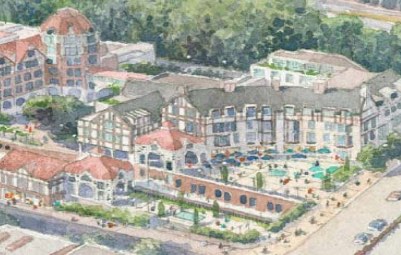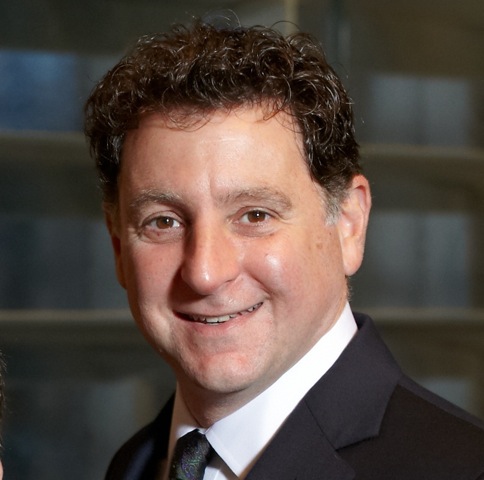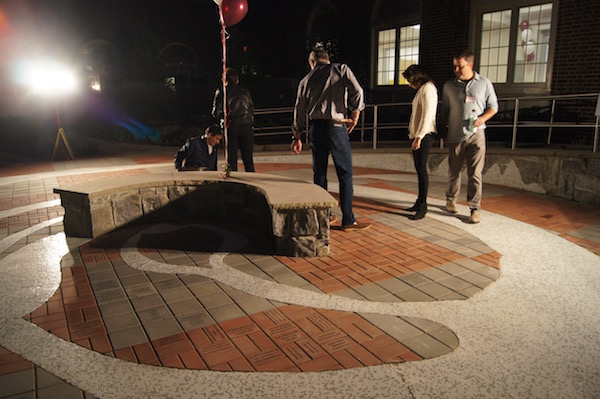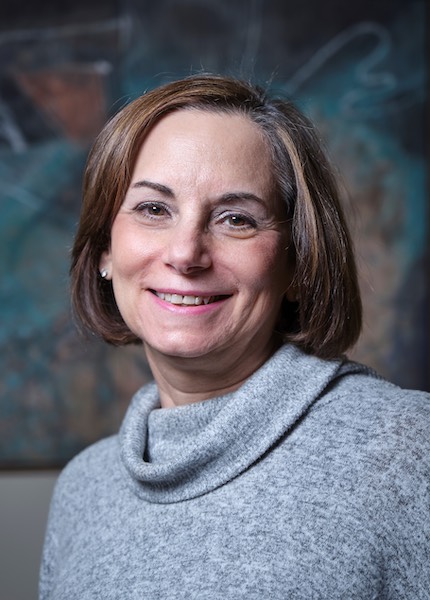Mayor and Deputy Mayor Provide Update on Development at Freightway Site
- Details
- Written by: Joanne Wallenstein
- Hits: 4420
 Mayor Marc Samwick and Deputy Mayor Jane Veron sat down recently to discuss the May 15th public forum that will be held at Rutherford Hall at 7:00pm to address the redevelopment of the Freightway parking garage. Here is what they shared:
Mayor Marc Samwick and Deputy Mayor Jane Veron sat down recently to discuss the May 15th public forum that will be held at Rutherford Hall at 7:00pm to address the redevelopment of the Freightway parking garage. Here is what they shared:
We have been hearing a lot about the redevelopment of the Freightway parking garage; what’s going on with the project?
MS The Freightway parking garage was built in 1972 and is currently in need of nearly $2.5 million of repair and upgrade work. After looking at the very successful development of Christie Place, the Village Board decided to assess resident interest in the potential redevelopment of the Freightway garage site. For those of you who might remember, Christie Place was nearly built as a stand-alone parking garage at taxpayer’s expense. At the last minute, the Christie Place project shifted and is now a vibrant residential and retail hub with below-grade parking for village residents. Learning from that experience, in 2017, the Village Board chose to take a proactive approach, initiating a visioning study. The results showed support for a redevelopment under a model similar to that of Christie Place.
JV We are fortunate that at this moment when we are considering the possibilities for Freightway, the development community has demonstrated strong interest in transit-oriented development (TOD). With the goal of attracting millennials and empty nesters, many neighboring communities have pursued TOD opportunities. In this environment, Scarsdale has the chance to evaluate again a potential taxpayer funded parking garage as compared to a new residential and parking structure funded by a private developer. If Scarsdale enters into a public-private partnership, the mixed-use development would seek to integrate both sides of our Village Center and to create sustainable benefits to our community, such as public open space and better pedestrian connectivity, all funded by the developer.
Where are we in the process and how can we expect the process to continue going forward? Marc Samwick
Marc Samwick
JV Last July, we initiated a two-step process to engage with the development community. At that time, we issued a Request for Expression of Interest (RFEI) to private developers who might be interested in partnering with the Village to create a new hub that would bring vitality to our Village Center. The foundation for the RFEI were the guiding principles developed by the community through the visioning study. We were very pleased to receive seven responses from top developers that addressed these principles. The next step in the process will be to issue a Request for Proposals (RFP), where the development community is asked to offer more detailed plans. The process continues with interviews, presentations and ultimately the selection of a Preferred Developer; negotiation of a mutually acceptable development agreement with the Preferred Developer; and the standard land use process which will include the Planning Board, Board of Architectural Review and the Village Board.
What’s happening at this Community Engagement Meeting and why is it important to attend?
MS - The Village recently retained a planning firm, AKRF, to advise the Village on the Freightway project. AKRF has extensive experience throughout Westchester County, the New York Metropolitan Area and the Boston-Washington corridor and has worked on TOD projects involving the MTA. They bring valuable experience to the project. The meeting on May 15th is designed to introduce AKRF to the community and to provide the community with the opportunity to express its preferences about the redeveloped Freightway site prior to the issuance of a Request for Proposals in June. Residents are encouraged to review the responses to the RFEI here prior to the public forum.
What is the timeline for the next steps in the project?
MS - As I mentioned, on May 15th we will hold a Community Engagement Meeting at 7 pm in Rutherford Hall with our planning consultant, AKRF. The intent of the meeting is to bring residents up to date on the Freightway process and to engage the public prior to issuing the RFP. The Village expects to issue the RFP in June 2019. The development community has been waiting to hear back from the Village since the RFEI submissions were provided in October 2018. We expect the RFP process to result in the selection of a Preferred Developer later in the year.
Anything else?
 Jane VeronJV - We encourage residents to attend the May 15th Community Engagement Meeting to hear more about the Freightway process and to share their preferences for the redevelopment of Freightway prior to the issuance of the RFP.
Jane VeronJV - We encourage residents to attend the May 15th Community Engagement Meeting to hear more about the Freightway process and to share their preferences for the redevelopment of Freightway prior to the issuance of the RFP.
MS - The Village Board started with extensive resident input through the visioning study and will continue to seek resident input throughout the process at events such as this public forum.
JV - The Village Board is focused on issues that matter to residents, namely the potential impact on parking, traffic and schools among others. There will be ample time to address these matters, and other potential concerns, as we better understand the plans that are developed for the Freightway site.
MS - We believe that we are embarking on a project that can materially enhance our Village Center, and we look forward to creating a shared vision with the community.
Lights On at Butler Field – How Many Hours Per Week?
- Details
- Written by: Joanne Wallenstein
- Hits: 3845
 How many nights would the lights be on at Butler Field if the plan to install them goes ahead? And how would the lights, noise and traffic impact the neighborhood?
How many nights would the lights be on at Butler Field if the plan to install them goes ahead? And how would the lights, noise and traffic impact the neighborhood?
That’s what Scarsdale Athletic Director Ray Pappalardi sought to clarify at the Scarsdale Board of Education meeting on Monday night April 29. Using a rubric from Rye, Pappalardi mapped out a plan for how many nights the lights would be on until 8 pm, 9 pm and 10:30 pm.
Discussing the mitigation of effects from noise, light and traffic, Pappalardi conceded that the district would not be able to manage unamplified noise during evening practices and games. He said there was no way to control the sound of kids playing, referees whistles and spectators cheering. However the use of a targeted sound system, which could be purchased for around $30,000, would control the effects of amplified sound from the announcer.
About the light, Pappalardi suggested that the planting of a natural screen of Green Giant Arborvitae would help to cut down on the light on the neighbors and quoted a fee of $5,000 for 50 trees.
About the schedule, Pappalardi showed the proposed calendar below outlining the field usage and “lights out” times for field usage based on 2019-20 dates.

He anticipated the following number of night games per year:
Up to 15 scheduled night games
--5 with lights off by 10:30 pm
--10 with lights off by 9:00 pm
Up to 4 playoff games with lights off by 10:30 pm
Up to 2 night games for each youth Independent Sports Organization including Rec Football, Boys' Soccer, Girls' Soccer, Boys' Lacrosse & Girls' Lacrosse for a total of 10 games.
That makes 29 night games per school year.
Lights would be used for the fall season from August 19 to November 15 and in the spring from March 9 through May 29.
In addition, the lights would be used for practices almost every night during the season until 8 pm. Here is what the proposed memorandum outlines:
“A maximum of ninety (90) athletic practices and twilight games (other than weekend events) using lights shall be allowed at the stadium during any given school year. Within the 90 events, a maximum of thirty (30) practices may be scheduled in the fall and spring and shall end with lights off by 8:00p.m, Monday through Friday only. An additional maximum of thirty (30) events may be scheduled in the fall and spring as twilight games at the stadium in any given school year. These games shall be scheduled Monday through Friday only with lights off by 8:00p.m. or 30 minutes after the end of the event in case of an injury delay, overtime or a significant public safety event.”
It is interesting to note, that the document from the Rye Board of Education upon which the Scarsdale draft is based allows for a total of 16 night games – rather than 29 games in the Scarsdale draft, and 70 practices until 8 pm in Rye, rather than 90 in the Scarsdale draft.
In the public comments portion, the Board heard from both a supporter of the plan and a neighbor with concerns about the policy.
Speaking for the “Light the Future Committee” of Maroon and White , Matt Conlan of Madison Road discussed the benefits of the lights and the need for a tiered donation policy.
He said, “350 players use the field and another 400 use it occasionally. That’s more than half the school. Extending the usage beyond sunlight is a huge asset for the community…. Through discussions we have learned that the neighbor’s biggest concern is the noise that accompanies field usage. Ray has been looking at an amplified system that will be a win-win. Garbage, parking and traffic have also been brought up and will be addressed by the school’s event management strategy.
…This will allow practices and games that were otherwise shortened by sundown to be played and conducted normally. This will allow them to play their full games.
…Among our prospective donors there are a lot of principled objections, that our property taxes, the highest in the country, can’t cover lights on the sole turf field in the community. The community wants lights, the student athletes certainly want lights and having a donor recognition plan is critical to raising money outside the school budget. …
Our intention is to recognize every donor … no matter the size…. The lower donors (will be recognized in the Scarsdale  Maroon and White is requesting a tiered donor recognition policy as there will not be enough space or funds to recognize all donors with inscribed pavers.Inquirer, on our website and in our sports journal. Permanent recognition costs money and takes up space. A paver brick costs about $35. Making that available for a $250 donation means that 15% goes back into it. … We don’t have a enough physical space to put a brick down for every $250 increment of donation – We will be seeking a tiered recognition plan with $1,000 as the minimum for recognition for practical reasons….
Maroon and White is requesting a tiered donor recognition policy as there will not be enough space or funds to recognize all donors with inscribed pavers.Inquirer, on our website and in our sports journal. Permanent recognition costs money and takes up space. A paver brick costs about $35. Making that available for a $250 donation means that 15% goes back into it. … We don’t have a enough physical space to put a brick down for every $250 increment of donation – We will be seeking a tiered recognition plan with $1,000 as the minimum for recognition for practical reasons….
…The plan needs to be tiered so that we can recognize a $10,000 donor – rather than ten, $1,000 donations. The real inclusivity is the lights. That’s what we should be focused on. Everyone will benefit from those lights. Our purpose is to improve the athletic experience for everyone.”
Commenting on the proposed schedule of use for the lights, Susan Kohn of 20 Carstensen Road thanked Ray and community leaders who have worked together. She said, “We only saw the proposed policy on Thursday. The neighbors will provide you with feedback on the policy. …We used a policy that was adopted by Rye as a starting point but the proposed policy is much broader than the one in Rye and much broader than the neighbors would feel is satisfactory in terms of scopes of usage….
…. Our concerns are real. Weekly practices every night on weeknights are a living reality for those of us who live around the field …. it’s week night, school night disruption for every night of the school year. While we support student athletics the concept of well-being and having quiet in order to study – as academics come first – is of primary importance.”
Commenting after the meeting, Kohn added: "With respect to the proposal that Ray provided to the Board, involved neighbors are concerned about a number of provisions. In general and among other things: The hours and frequency of usage are too broad; there is no statement of consequences for violations or mechanism for enforcement; and there are continuing concerns about the level of noise, light, and traffic even with proposed amelioration, as we are being asked to make a leap of faith that the proposed systems will work. (For instance, we do not have engineering specifications or other objective information on which to evaluate the effectiveness of the proposed lighting and sound systems.) There are legitimate concerns about the effects of extended use of the field on students, including those on the field and those in neighboring houses (these two groups are not mutually exclusive - we are parents of student athletes, too!), that have not been studied or addressed.
We will be submitting a more detailed response to the Board and to Ray shortly. The issues raised by the current proposal are not unique to a community like Scarsdale. Please note that the policy in Rye, which was used as a model for Ray’s draft, better addresses many of our concerns. For instance, frequency and time periods permitted for usage of lights are much greater in Ray’s proposal than what is permitted in Rye, and Rye’s proposal clearly sets forth consequences for policy violations."
The Board also reviewed proposed changes to the district gift policy concerning donor recognition and other matters that can be reviewed here.
SHS Student Attends Flower in the Gun Festival
- Details
- Written by: Jordy Love
- Hits: 3326

US Representative Ted Deutch represents Florida’s 22nd congressional district and has been committed to passing sensible gun violence prevention legislation to keep all citizens safe. The spoken word artists who performed were students who survived the Parkland massacre and moved the entire audience with their poetic accounts. Musician Michael Franti performed his song, “The Flower,” which he co-wrote to be an anthem for the movement to end gun violence. Franti’s video displays families and individuals from across the country who were affected by gun violence which touches every corner and every walk of life. Franti became involved in gun violence awareness when he noticed bullet holes in the walls in his home and found a bullet in an adjacent room. He was fortunate to be away when the stray bullet made its way through his home but realized the need to take action. Franti hopes this song helps others to see that all people, no matter what walk of life, or political perspective, gun owner or not, has a role to play in reducing the number of gun deaths in the country each day.
The festival showcased a collection of artwork by Adam Dolle titled “First Awakenings” centered around the theme of the roles of guns in the United States that seek to highlight the ordinariness of gun violence in everyday lives. His work displays two sides of the gun debate from in front of a gun or behind one. It is heartbreaking that stories of mass shootings, suicide, and murder have become commonplace and are heard practically every day. The statistics are shocking with 400 privately owned guns in the US, 40,000 deaths annually, 60% of those deaths from suicide, and nearly 3,000 children’s deaths attributed to guns.
The piece titled Rat-ta-tat-tat drew inspiration from the advertisement texts for toy assault rifles sold on toy stores and on Amazon.
On February 13, 2019, one day before the one-year anniversary of the Marjory Stoneman Douglas massacre, the House Judiciary Committee passed legislation to expand background check requirements for firearm purchase. Congressman Deutch, led a moment of silence for the 17 victims who were killed in the shooting and said, “I ask that we work together— not as Democrats and Republicans, but as Americans- to end the silence with action to make all our communities safer from gun violence, I ask that this moment of silence not be in vain.” The House Judiciary Committee voted in favor of the bill 23-15. Now, the bill will move on to the House floor. If this bill is enacted, it will be the most significant gun control legislation approved in the last decade.
The Proposed 2019-20 Village Budget: Explaining the Numbers
- Details
- Written by: Joanne Wallenstein
- Hits: 4512
 The proposed $58 million 2019-20 budget for Scarsdale Village was the subject of both a meeting of the League of Women Voters of Scarsdale on April 8 and a budget hearing at Village Hall on Tuesday night April 9.
The proposed $58 million 2019-20 budget for Scarsdale Village was the subject of both a meeting of the League of Women Voters of Scarsdale on April 8 and a budget hearing at Village Hall on Tuesday night April 9.
The tentative budget includes a $1,166,747 or 2.91% budget increase which means that a homeowner with a house valued at $1,515,000 would pay roughly $7,027 in Village taxes, which is a $256 increase over last year. Village taxes remain 18.32% of the total property tax bill, with school taxes accounting for 63.65% of the payment and an additional 18.04% for Westchester County.
At the meeting of the LWVS, Dara Gruenberg led a discussion about the budget with Village Manager Steve Pappalardo, Village Treasurer Mary Lou McClure, Trustee Justin Arest and Scarsdale Mayor Marc Samwick who responded to a list of questions that were presented in advance of the meeting.
Samwick explained that the Village tries to keep debt service payments level and only adds more debt when old debt rolls off. However, this year a payment for financing the library renovation rolled on before the last payment for debt on the Popham Road Bridge project which will roll off next year, resulting in a $452,000 increase in debt service.
About the general fund balance, Mary Lou McClure explained that the Village retains an unassigned fund balance of 10-15% to pay for unexpected expenses such as storm damage and repairs. Moody’s considers the level of fund balance when they grant their bond rating to the village.
Concerning road repair, this year the Village maintained a budget of $815,000 for road repair and hopes to transfer another $500,000 out of the general fund for additional road work. They are hoping to accelerate repaving and now require Con Edison to do curb-to-curb repaving of any roads they tear up when doing repairs or improvements.
Discussing capital projects, Pappalardo explained that the Village is currently doing work on our roads, sanitary and storm sewage system and water pipes. They are looking at the water distribution system to identify needed repairs in lines and valves, some of which are over 100 years old. If the valves are not functioning properly it is difficult to make repairs. Pappalardo said, “there is leakage in the system. $6 million is allocated over the next five years.” The work is being financed by the sewer rent fee and is not dependent on tax dollars.”
De-silting is also being done at Cayuga Pond, a $1.4 million project funded by a $1.1 million grant and a $350,000 contribution from the Village. The Hutchinson River bed and culverts are undergoing a clean-up with $2.5 million from the county, $1 million from the state and $620,000 or 20% from the Village of Scarsdale.
Pappalardo also reported that the renovation of the firehouse on Popham Road should be completed in a few weeks and that it will be back in service in May.
When asked about needed repairs at Village Hall, Pappalardo said, “We have to decide whether or not to fix this building. The building is old and tired. The old heating and ventilation system needs to be upgraded and the electrical system needs an upgrade in order to install a generator. The Court Room needs $1 million of work to upgrade security and it would be safer to move the dais to the left. The seats, carpeting, wood panels all need to be replaced. We need to consider whether we should build a new building or repair and renovate this one. When we renovated the public safety building we had to relocate the staff – and had to build out space to accommodate them. We could build a new building in the lower level of the lot and keep this one open as we build a new building.”
The League asked a question about evaluating the food scrap recycling program implemented last year. Pappalardo said, “Yes – it will be evaluated. The Village Manager will work with the CAC on the metrics. Gruenberg followed up, “Is it right for the CAC who are the proponents of the program to be the ones evaluating it?” Pappalardo replied, “We will look at the metrics, we will look at the number of participants – and decide where we go from here.” Mayor Marc Samwick added, “There is the potential for a perception of conflict – we need to give some thought to this,” and Trustee Justin Arest said, “My hope is that the data come from staff.”
In response to a question about water rates, Pappalardo said, “Water rate changes were made to address our needs – but we need to build up the water reserves,” Mary Lou McClure added, “ We are replacing water meters and installing remote reading systems to allow the meters to be read electronically. This will allow us to read the meters on a real time basis. We will also move to a monthly billing system so that users can be alerted if they have excess usage or a leak. We could also have a user portal so that residents can pay online and reduce our mailing costs.”
Pappalardo added, “We have been dependent on those who use a lot of water to pay the excess rates. But as people monitor more closely, they will use less and not fund the water enterprise fund.”
At a public hearing about the Village Budget at the Board of Trustees meeting on April 9, the board defended the budget in light of comments from Bob Berg and Bob Harrison.
Berg objected to the 2.91% increase calling the budget a “rollover from last year that fails to recognize the game changing limitations on the SALT deductions which limits the ability of many taxpayers to deduct state and local taxes.”
He said, the change has “impacted the real estate market dramatically and the number of houses on the market has increased dramatically, the days any house is on the market has increased and the median sales price has dropped precipitously.” He added, “Property taxes are a huge factor.”
He called Assemblywoman Amy Paulin’s lawsuit to challenge the ruling “ridiculous” and said the “lawsuit will go no place and make Scarsdale the laughing stock of the nation.”
He objected to adding a part-time code enforcer at a cost of $35,000 to the budget, claiming, “All the village needs to do is to tell their department heads to enforce the code. You can do that without hiring someone for $35,000 to enforce the code.”
He also objected to a $100,000 fee for a planning study for the Village Recreation Department that was funded in the 2018-19 budget and to a 2% salary increase for non-union staff, asking the managers to do a study to see if staff was underpaid.
Bob Harrison said, “I think we have to hold down taxes for our residents and I think 2.71% is too much. The CPI is running around 2%. He said, “Limit the tax increases – it is so harsh on our community. Look for ways to hold down our expenses.”
Responding to Berg and Harrison, Mayor Samwick said, “75% of the budget is labor related costs that are subject to long term collective bargaining agreements. We provide long-term retirement programs that are not within our control. These benefit costs have grown at phenomenal rates. The unfunded mandates are a phenomenal burden. We have infrastructure projects, roads and sewer lines – that all need work. We are acutely aware of what is coming out of Washington. We appreciate your feedback and your comments.”
And Trustee Seth Ross said, “ It’s tempting to use the CPI figure but it is not relevant. We have costs that go up independent of CPI. It is a problem in budgeting and messaging.”
Pappaplardo also explained the pressure on the Village budget saying, “Between health insurance, pension, FICA and debt service those four items accounted for $1 million of the $4 million spending increase.”
Learn more about where your Village taxes go here:
Scarsdale Bowl to Honor Jill Spieler April 10
- Details
- Written by: Joanne Wallenstein
- Hits: 6432
 Scarsdale Bowl Recipient Jill Spieler: Photo Credit Michael ChayesPleasePlease
Scarsdale Bowl Recipient Jill Spieler: Photo Credit Michael ChayesPleasePlease
RSVP via PayPal by April 5th:
Jill Spieler, a Scarsdale resident with 40 years of dedicated volunteerism, will be the 2019 recipient of the community’s highest award, the Scarsdale Bowl. The dinner will be held on Wednesday April 10 at Mulino’s at Lake Isle and the entire community is invited to celebrate Jill and volunteerism in Scarsdale. Click here to learn more:
We asked Jill a few questions about living and volunteering in Scarsdale, and here is what she shared:
How many years have you lived in Scarsdale and how did you begin volunteering? What were a few of your early activities?
I moved to Edgewood in 1976. In 1979 my first child was born. That same year my husband started to work from home. We needed a bigger house, so we moved to Greenacres in 1980. We have been in our current home for 39 years.
In Greenacres I met many other young women who already had elementary age children. They were involved with the yearly PTA fund raiser. I asked if I could help? I wanted to be involved, enjoy the new friendships I was making.
My first big commitment was getting involved with the Child Care Association of Scarsdale (Kids BASE),
an idea that came out of PT Council. More moms were going back to work and there weren’t many licensed, educational child care programs in the county for elementary school age children. This was something I valued, so I volunteered wherever I could. I was asked to join the Board in 1984.
Looking back — what were your favorite volunteer jobs in Scarsdale – and why?
Working on the Kids BASE board gave me an incredible opportunity to work with many creative, intelligent, caring women. Most of them were already leaders in many other community organizations. I learned so much during those early years.
There were many challenges during the first few years. Developing the program, building a following, and, most of all the constant question, “Where will there be room for us next year?” The sale of the American Legion Hall couldn’t have come at a better time. Not without controversy, but with many supporters, the Village and Kid BASE Boards worked out an agreement for Kids BASE to lease the property. Plans for the building, setting up the bonds, selling the bonds, and seeing it through. All these efforts and so many more details took dedication from numerous Board members and community volunteers. It was so exciting to see the finished building, with little chairs and tables, educational toys, a gym, outdoor playground equipment and a kitchen for preparing meals. It was such a gratifying moment for everyone involved.
One of the most engaging, fun, jobs I had was being President of the TVCCEF (Scarsdale Forum) as they were going into their 100th Year. I had a first-hand opportunity to learn about the history, and important studies the TVCCEF had done over the past 100 years. It was an exhilarating time. Working with many community members and reuniting so many past leaders of the TVCCEF. We had a wonderful turnout of over 300 people and raised $100,000 for the TVCCEF, which would help as we moved forward in our efforts to educate and inform Scarsdale residents with stimulating, thoughtful, provoking debate and conversations.
What was one of the toughest jobs you held?
There were many challenges over the years. The hardest times were when the community was at odds on an issue. I found it especially difficult when I was the chair of an organization, whether it be PRC, Scarsdale Forum or the Board of Education. You try your hardest to listen, be open minded, and have all sides heard from. Ultimately there needs to be some decisions to move the question forward. Sometimes the answer is working towards compromise, but that’s not always attainable. With the help of my peers, we tried our best to make the right choices.
Why do you like living in Scarsdale?
I have enjoyed living it Scarsdale because it gave me a sense of community. I took pleasure in watching my own children growing up with their friends. I made many friends through my children. And many more friends volunteering. I truly appreciate the sharing of knowledge between generations that I have experienced.
What do you enjoy about the community –favorite activities, restaurants?
I am grateful for the education my children received, and the fun they had participating in Rec programs, day camp and at the pool. I am looking forward to the library renovation. My husband and I frequent many of the restaurants in Scarsdale. We are enjoying the new additions on Garth Road.
Some empty nesters decide to leave the community after their kids are grown. Why did you decide to stay?
I love my home, and still want to be part of the Scarsdale community. I like to be able to participate in some of the LVW and Forum activities. I enjoy bumping into familiar faces in town and enjoy occasionally volunteering on smaller projects.
What would you tell new residents about volunteering? Why should they get involved?
I know most of us move here for the Schools, but there is much to gain if one invests the time. You will be able to share your views, learn something and teach someone as well. You meet many people of different interests, feel part of something bigger than yourself, leave something behind for a community that has given so much to you and your family.
Were you surprised to learn you had been nominated to receive the Scarsdale Bowl?
Yes, it was unexpected. When you volunteer it is because you want to contribute your time to a good cause. Or someone has asked, and you feel it would be an interesting opportunity. I never looked back to see how involved I had been for so many years. I feel very honored, and fortunate to have had so many interesting experiences. I have met wonderful people from all areas of the community, across many generations.











